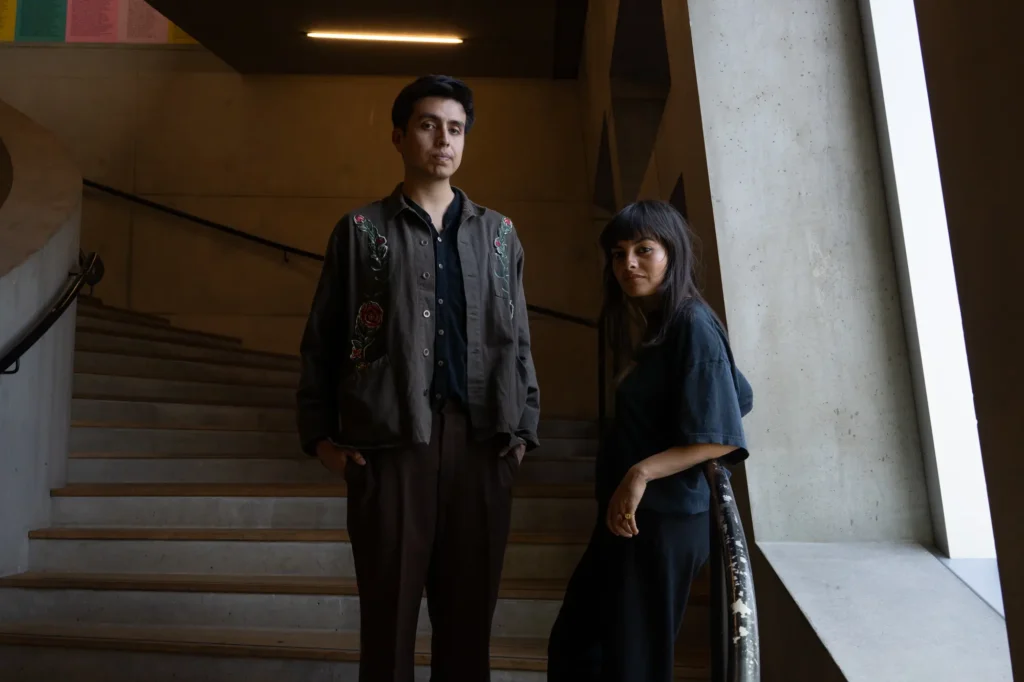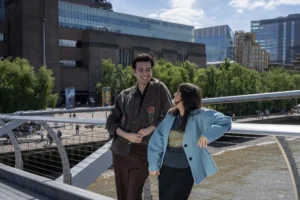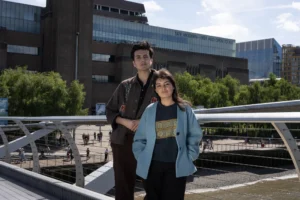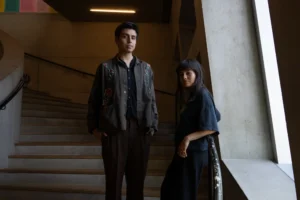However much we know that things must change in society and most specifically in the systems that we have created on this planet we call home; the difficulty can sometimes hinge on the fact that it’s simply challenging to imagine a new kind of future. We are faced with a crisis of imagination and overwhelmed by the daunting task in front of us. But what if there was a way to get together and dream about this new kind of future, one that at the root was inclusive and accepting of all of our differences as humans. Kalpana Arias and Isaias Hernandez, two well-known figures in the climate activist space, have attempted to do just that – provide an annual event dedicated to culture and deep exchange as an alternative to the stuffy and often frustrating bureaucratic merry-go-around that have come to define the classic climate conference.
Before we talk about the Symbiocene, let’s go back a little and talk about your individual backgrounds as activists. What was the initial spark or moment that made you think “this is what I am going to dedicate my time to”?
Kalpana Arias I’m a guerrilla gardener, a technologist, an urban greening activist, and I founded an organisation called Nowadays on Earth. It’s a social enterprise that supports people connecting to urban nature, but also advocates for more urban nature in a city where we often face nature depletion. It’s really hard to pinpoint an exact moment where the passion for my projects grew, because I feel like all of my work is an extension of myself and my identity, and how I’m figuring out my place and my role in the world.
I guess unconscious seeds began to sprout during the pandemic, when we were experiencing a lot of isolation. We couldn’t go into parks or into regular community gardens or green spaces. A friend of mine in our little bubble was guerrilla gardening and throwing out seeds.
And that – I remember just the act of doing that made me really, really happy – finding that sense of connection at a time when the world was incredibly isolated.
Rooting myself back into my local community and my local spaces, I think, helped me figure out more of who I was and what I wanted to do. That sort of sparked a lot of the initiatives that we’re now doing four years down the line, which is using technology as an interface to help people connect to nature by building an app that connects all of London’s green spaces together, including community gardens and guerrilla gardening sites.
Isaias Hernandez I’m an environmentalist and creative under the moniker Queer Brown Vegan. My start into environmentalism really came from a deep place of curiosity and wanting to learn and develop new thoughts. I think growing up in poverty from a first-generation Latino household, I was really taught to always be grateful for what I had, but to also understand the ethics of being able to learn, to be able to teach, to be able to share and to really reciprocate that back to the world.
I created Queer Brown Vegan which hosts as an environmental education platform that really focuses on providing intersectional environmental education and bringing together these large topics from different industries and collapsing them onto the floor like puzzle pieces and finding how they’re connected to each other and recognising that they’re not isolated subjects. And I would say that, independent climate media education means so much to me because as someone who grew up watching TV shows on Nat Geo and Discovery Channel, I never really saw an environmentalist that was brown. It was typically white faces.
I really wanted to showcase to marginalised communities, specifically Latino communities, how you can actually see yourself in these spaces. As someone who also has a queer identity, it was also important to demonstrate that your identity is not so much a hindrance, but rather an extension of how you see the world. And that to me is what gives me the light to continue producing all of this independent work.
And now I’m able to work together with these different industries, from academic institutions, to corporate, to non-profit, to artists, which creates a holistic education that allows people to feel part of the solution and to know that we don’t really exist in a singular dimension.
In all of the years of activism in your respective domains, what are the most essential lessons that you have learned?
KA – Even though our communities are living through crisis and sort of continuing on this thread of survival, they’re still managing to thrive in some way. They’re still managing to find joy and find community and love. I think for me, the last couple of years has been sort of revealing into what world-making really means.
And I love the idea of the pluriverse – there is a universe in which many worlds can coexist and can be. So, what I’m really dropping into deeper now is seeing that I’m not necessarily going to be able to exist within the dominant culture, white environmentalism space. And that’s completely okay because I’m trying to build my world and I’m trying to build for my communities because I want them to thrive and I want them to continue to exist and to live on.

Photography by Chiara Luxardo
And I’m working for the legacy of the generations to come that are rooted within those dreams. I think sometimes a lot of the tension that we find in culture is because we’re trying to merge so many, I guess, dominant identities or attitudes together when they can just coexist, and they don’t mess. I love what Sophie Strand says around kinship. I think we normally associate kinship with family, but in reality, in the natural sciences, kinship is anything from parasitism to mutualism.
In the same way, our worlds can just coexist in a way that is cooperative and friendly, but they don’t necessarily always need to be one together.
In short, what world-building means, is making for your communities, and creating spaces that are outside of normal culture. And that means doing something completely different to what the world might be doing at the time.
I’m here to inspire. I’m here to spark some new imagination and new thoughts in people so that their perspective opens up and shifts in a different direction. But it doesn’t mean that they have to believe my beliefs either. I am not here to change their mind. How can we approach each other with kindness and compassion around different ways of thinking rather than stomping on one another?
IH – I think a lot of my anger has transformed into different forms of energetic expression. When I was younger, I was very ashamed of not really knowing too much. I never felt smart enough. I actually remember being the activist that was always behind everyone, like at the far end and not talking. I always saw myself in this role of learning, educating and helping people as much as I can. I had no interest in speaking or really not centering anything. I actually was against social media.
Then I realised that there were really not that many people of colour. So, I was like, well, actually there is a lot I can do. But I think one thing I learned about activism is that as you get older, everything becomes more nuanced.
I think I used to have a very fixed binary mindset of it’s either this way or the highway. And I say this because I believe that often times, youth activist spaces can be full of sacrificial mindsets of: you need to be able to give 100%, everything, to this movement. Otherwise, you’re a failure or you don’t care about the community. But I think that we have really failed our young people to provide sustainable strategies of what it means to nurture themselves, to hold themselves accountable, but to also be young, to be messy, to make mistakes, to learn.
You’re still both very much active in your respective engagements, how did the idea of Symbiocene come about?
KA- Isaias and I met at COP in Glasgow and it was a very white space. We saw very little representation of our communities and people who looked like us, who sort of valued the same things. We just got into a personal conversation but were also sharing our frustrations around the space.
IH- I actually was going through a really tough breakup during COP26, and it was a very isolating experience for me. One, because it was my first time ever in London and then Glasgow, Scotland. But two is that I was in a very predominantly white space where I really felt that I didn’t know any community, and when you’re already in a high-level policy institutional space, those spaces are not really made for you.
I remember having to do a main stage panel for the New York Times. I remember having to get myself together and go to the panel and wipe away my tears and act like nothing happened. And after the event, seeing Kalpana who rushed over to me and hugged me and told me it’s going to be okay. I saw her as my lifeline at the time.
It was really impactful because I think those are the moments that you find these gems in the climate space.
And from that point on, we promised each other that we would find a way to work together in the future. It took a while, but I think we both kind of understood that, you know, each year I would come to visit London that we would both say like, it’s not time yet, but it will be happening soon. Yeah, the seeds were definitely planted.
Photography by Chiara Luxardo
KA – Our friendship really set in Glasgow. And it felt also like looking at radical acts of love.
In some ways that’s really what’s brought the Symbiocene together. For us, it’s been about how do we create a space of love and transformation that doesn’t force something from you, but it’s a space that accepts you totally for who you are. And I think it does that in so many different ways.
IH – We have different expressions of creativity, but I think that where it really flourishes is when it comes to bouncing off ideas. I remember walking in sunny Los Angeles and texting Kalpana, “What about the Symbiocene – does that sound like something cool you’d go to?”
KA- It’s actually a really unique dimension. How do we make something happen that is really reflective of the spaces that we want to be in? I think my frustration in this world comes out of, you know, the world that I see and live in, in some respects, is not the reality that I want for all of us to live in. And so instead of waiting for it, how do we make it happen? And I think the Symbiocene is really rooted in that. The vision with the Symbiocene has always been for people to dream along with us.
We’re kind of like the space holders, but we want everyone’s imaginations there and not just human, but also non-human communities. I’m super excited about that because we’re having a mushroom concert by Auntie Flo, for example.
We’re bringing in different workshops where people can actually embody plant thinking and plant world making.
This is a space to push boundaries as well. We don’t want to keep having the same conversations or create the same actions.
So, what is your ultimate aim with this event?
KA- In summary, to really make another world possible. To not just talk about it, but to build it. Really, when we’re talking about future building and creating a world that is equitable, that is green, what are the paths and methodologies that are going to get us there? It’s funny, because we both have built organizations separately out of that same need of not seeing that representation, and now we’ve come together to build something that’s bigger, more inclusive, and that invites everyone to dream together.
IH- We really want to make sure that these are the ways that we leave behind our legacy.
I think we’re trying to lay that foundation with the Symbiocene – if we’re able to break the barriers of what a dominant environmental conference or event looks like, then we’re going to make it fun. It will be the next Coachella. This is really a blueprint, like the mechanics of how we’re organizing the summit, involving arts, culture, education, music – it’s really a blueprint for climate action in a global context.
This year you’re digging into bioanarchy: an opportunity to root into chaos and elevate the disorderly in nature and beyond. Together we’ll be exploring the world we live in, its complex systems, enmeshed, volatile and unpredictable, and what we can learn from anarchy to make another world possible. Where did this idea of learning from anarchy come from?
KA- I mean, I took a lot of inspiration in bioanarchy, which is, you know, sort of biocentric anarchy, so how nature is basically a reflection of chaos, of universal chaos, right? And I take a lot of inspiration from guerrilla gardening, the movements in New York City in the 1970s, but then also just how the movement continues to sustain a lot of groups and marginalised communities in London, from the Garden of Earthly Delights to Coco Collective, and to people who are literally just trying to survive in the city, but also wanting to take care for their communities and doing it alongside nature. And so, I don’t know, the gardening movement for me is always incredibly inspiring because it’s a direct connection to land and to disorder and to the, you know, boundless nature of the world around us and just how we can kind of reclaim that wildness again.
IH- I think from my end as an educator, learning about the ways that we criminalise, or I would say categorise individuals who attempt to promote diversity and go against uniformity like, agroterrorism and aquatic terrorism. How individuals have attempted to stop the increasing monocultural mindset of large corporate industries that are really trying to deplete our natural resources. And so, seeing individuals like forest protectors, for example, like tree huggers, being labelled as ecoterrorists by these corporations’ kind of creates this unique dichotomy of, like, really, who is the one that is absorbing the violence? I think the thing about anarchy, or a rebellious nature is, it taps into our individuality or into, the spaces within ourselves which we’re curious to kind of figure out. I think it speaks to the the wilderness within us, like the wild nature within us that we don’t know.
The London event is taking place June 22nd, 2024 at Omved gardens.



